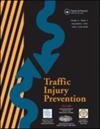基于线形与环境特征的碰撞风险预测与分析——以丘陵地区高速公路为例
IF 1.9
3区 工程技术
Q3 PUBLIC, ENVIRONMENTAL & OCCUPATIONAL HEALTH
引用次数: 0
摘要
目的:丘陵地区高速公路线形复杂,环境受地形条件制约,对生命财产安全构成重大威胁。本研究旨在通过线形和环境特征对丘陵地区高速公路的碰撞风险进行预测,并找出高风险的决定因素进行安全改进。方法:基于西南某高速公路5年交通事故伤亡和财产损失数据,采用排序技术和5种聚类算法确定风险等级并进行分类。采用DeepLabv3模型对环境特征进行语义分割。研究建立了四种集成学习模型来预测碰撞风险,并采用可解释模型方法来理解贡献特征。结果:XGBoost综合性能最佳,准确率达到0.9259,F1得分达到0.8886。卡车和汽车的比例和变化率、建筑和道路的比例与高风险呈正相关,植被和道路的比例与高风险负相关。水平和垂直排列,包括较长的陡坡,较小的曲线半径,较短的过渡曲线,较小的凸和凹曲线半径,与高风险有关。结论:本研究提出了一种无需历史碰撞数据的路段碰撞风险预测方法。将XGBoost模型与SHAP方法相结合,可以利用路线和环境特征准确识别丘陵地区高速公路的风险,并增强对这些因素如何导致高风险的理解。本文章由计算机程序翻译,如有差异,请以英文原文为准。
Crash risk prediction and analysis from the perspective of alignment and environment features: A study on an expressway in a hilly area
Objective
Expressways in hilly areas feature complex alignment and environments constrained by terrain conditions, significantly threatening life and property safety. This study aims to investigate crash risk prediction of expressways in hilly areas through alignment and environment features and identify determinants of the high risk for safety improvement.
Methods
Based on 5 years of crash data on casualties and property damage of an expressway in southwestern China, the order technique and five clustering algorithms were employed to determine and classify risk levels. Environment features were extracted by semantic segmentation with a DeepLabv3 model. The study established four ensemble learning models to predict crash risks, and the interpretable model approach was adopted to understand contributing features.
Results
XGBoost achieved the best overall performance, with the accuracy and F1 score reaching 0.9259 and 0.8886. The proportion and variation rate of trucks and cars, and the proportions of constructions and the road positively correlated with high risks, while the proportions of the vegetation and road had negative correlations. The horizontal and vertical alignments, including long steep slopes, smaller curve radii, shorter transition curves, and smaller convex and concave curves radii, were linked to high risks.
Conclusions
This study proposes an approach to predict crash risks on road sections without historical crash data. Combining the XGBoost model with the SHAP approach, enables accurate identification of risks on expressways in hilly areas using alignment and environment features and enhances the understanding of how these factors contribute to high risks.
求助全文
通过发布文献求助,成功后即可免费获取论文全文。
去求助
来源期刊

Traffic Injury Prevention
PUBLIC, ENVIRONMENTAL & OCCUPATIONAL HEALTH-
CiteScore
3.60
自引率
10.00%
发文量
137
审稿时长
3 months
期刊介绍:
The purpose of Traffic Injury Prevention is to bridge the disciplines of medicine, engineering, public health and traffic safety in order to foster the science of traffic injury prevention. The archival journal focuses on research, interventions and evaluations within the areas of traffic safety, crash causation, injury prevention and treatment.
General topics within the journal''s scope are driver behavior, road infrastructure, emerging crash avoidance technologies, crash and injury epidemiology, alcohol and drugs, impact injury biomechanics, vehicle crashworthiness, occupant restraints, pedestrian safety, evaluation of interventions, economic consequences and emergency and clinical care with specific application to traffic injury prevention. The journal includes full length papers, review articles, case studies, brief technical notes and commentaries.
 求助内容:
求助内容: 应助结果提醒方式:
应助结果提醒方式:


